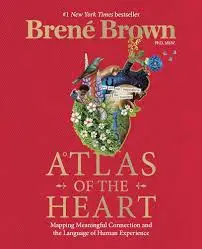
Atlas of the Heart
Mapping Meaningful Connection and the Language of Human Experience
Brené Brown
Random House (2021)
- Emotional
- Book, Premium Content, Resource Summary
Key Takeaways
- Name It to Tame It – Knowing the exact word for what you feel (e.g., “resentment” vs. “anger”) gives your brain clearer instructions for calming your nervous system.
- All Feelings Carry Information – Even “hard” emotions like jealousy or grief point to values, needs, or boundaries that matter to you.
- Language Builds Agency – A rich emotional vocabulary helps you ask for support, set limits, and strengthen relationships instead of shutting down.
- Understanding Fuels Connection – When you recognize your own emotions, you become better at recognizing and empathizing with others, reducing isolation on the FND journey.
Click to read full summary
The Essentials
Atlas of the Heart maps 87 distinct emotions and experiences, showing how precise language turns vague feelings into actionable insight. Brené Brown combines years of research with relatable stories to make complex psychology easy to grasp.
For people with Functional Neurological Disorder, this clarity is more than interesting—it’s regulating. Emotions that stay bottled up can keep the body in a fight-flight-freeze loop, intensifying fatigue, pain, and other FND symptoms. By learning the right words, readers gain tools to notice rising tension sooner and choose small, body-friendly responses that restore a sense of safety.
Why This Matters for FND
Many in the FND community feel dismissed when emotions enter the conversation. Brown reframes emotions as neutral data, not proof that symptoms are “all in your head.” Practicing her naming exercises can help calm the nervous system, reduce symptom flares, and open healthier dialogue with care partners and clinicians.
Resource Qualities
Applicability
Accessibility
Evidence-Based
Practical Value
Practical Applications
For Individuals with FND
Low-Energy Days
- Pick one moment (e.g., when symptoms spike) and label the feeling with a more precise word than “bad.” Say it out loud or jot it on a sticky note.
Building Long-Term Wellness
- Create a personal “emotion map.” Each evening, list three emotions you felt and one body sensation that went with each. Notice patterns over time.
For Individuals with FND
Supporting Your Loved One
- Gently ask, “Is it stress, frustration, or something else?” Offering choices can help your loved one find the right word without pressure.
- Share your own daily emotion word. Modeling vocabulary normalizes the practice and shows you’re learning alongside them.
Caring for Yourself
- After difficult caregiving moments, label your own emotions to prevent burnout and model healthy processing.
When This is Most Helpful
- Newly Diagnosed: Builds a non-judgmental framework for talking about symptoms.
- During Symptom Flares: Quick naming exercises can down-shift the nervous system.
- For Care Partners: Offers language to discuss tough moments without blame.
This summary is provided for informational purposes only and does not constitute medical, financial, or legal advice. It is not intended to replace professional consultation or treatment. Always consult qualified providers regarding your specific circumstances, symptoms, or questions.
